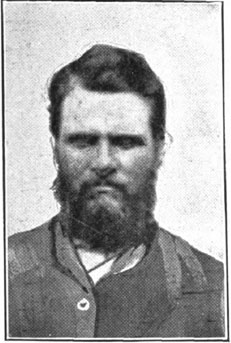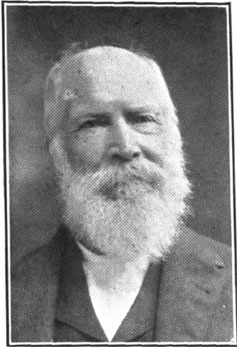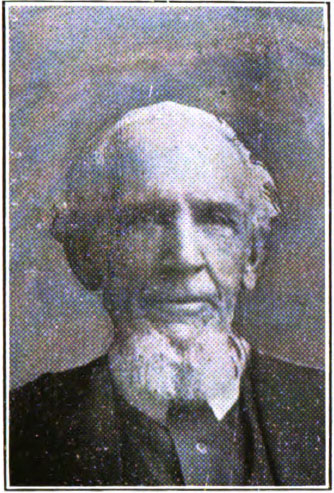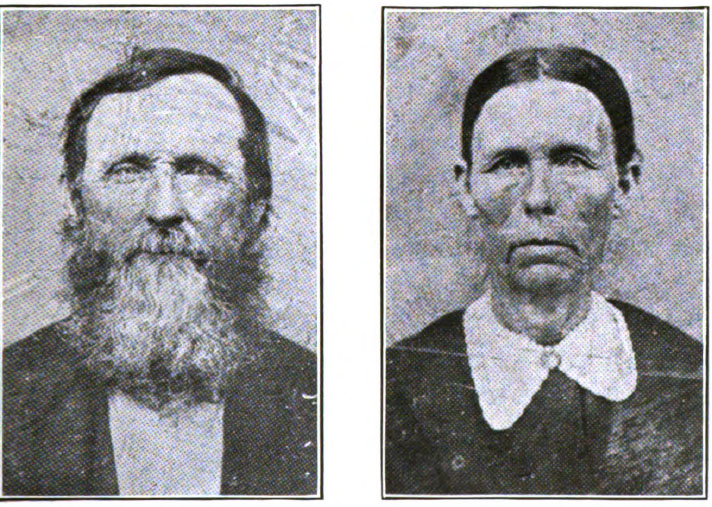|
CHAPTER III.
pg. 20
MADISON'S
ADVANCE GUARD OF CIVILIZATION
The Indian title to the land, of which Madison
County is a part, was extinguished in the year
1845. By treaty, the Government had
secured a large area of country, suitable for
cultivation and the bounteous production of
grain, grasses and other of the various food
stuffs indigenous to this latitude.
Strange to say, however, almost a year was
permitted to elapse before the white man came
and claimed "his own." It is not known
that any person, white, red or black, stepped
foot into Madison County before the year 1846,
for other purposes than of exploration, hunting
or trapping. Here were thousands of acres
of rich prairie lands and other thousands
covered by luxuriant growths of valuable timber.
Three beautiful rivers traversed and watered the
fertile soil, aided by many tributaries, and
fruits and honey were to be found in vast
quantities. Nature had provided lavishly
and beckoned, with eager and welcoming hand to
the countless thousands of men and women of the
Eastern states, to come and settle upon this
land, whose every feature and attribute was a
glowing and substantial promise of bounteous
harvests and consequent prosperity.
To Hiram Hurst is given the distinction of being
the first person to settled within the confines
of this splendid domain, designated as Madison
County. This advance guard of the splendid
host of men who peopled the county and made it
fructify so amazingly, migrated from Buchanan
County, Missouri, early in the year 1846 and, as
near as any one can compute the time, found his
way into that part of Madison County now known
as Crawford Township, on Apr. 1, 1846. The
country looked good to him. The three
requisites of the home builder were here in all
their fullness an dgraciousness:
Salubrious climate, abundance of pure, limpid
water and a supply of timber, which seemed at
the time almost inexhaustible. He had his
ax and a super aboundance of energy, strength
and ambition, all salient attributes of the
frontiersman. Nor was he lacking in
ambition to carve out a home and habitation for
himself and a large family dependent upon him.
Here he was, an Ishmael in the wilderness; an
involuntary absentee from his former haunts.
For it is part of the tradition surrounding this
historically interesting character that he was
compelled to leave Missouri; or, in other words,
he was a fugitive from justice. As
reputations go, when handled hither and yon by
the evil minded or credulouis, Hurst was
credited with having killed his man.
Another one had it that he burned a neighbor's
property in a spirit of vengeance, and again,
the story was rife in the early days that the
pioneer settler of Madison County was a petty
thief, in that he had stolen a bunch of Missouri
hogs. These were the idle and harmful
tales extant among those who followed Hurst
into the wilderness, but the real char-
|

HIRAM HURST
First white settler in Madison
County. Came from Missouri
about April 15, 1846. First
claim in section 36 of the (now)
Crawford Township, near the present
home of Joseph H. Duff.
Left in 1854 for Nebraska, where he
died in 1889. |
|

GUY W. GUYE
Came to Madison County, May 3, 1846.
Voted on the adoption of the
Constitution, August, 1846, at Fort
Des Moines, and has voted at all
principal elections since.
Entered the first piece of land in
Madison County in January, 1850. |
Page 21 -
acter of the man and the place he attained in
the confidence of his new neighbors are not
consistent and moral turpitude and wrong doing.
Hurst built a little "shack" in the timber, and
cultivated a small patch of corn in the spring
and summer of 1846. In the fall of that
year he returned to his old home in Buchanan
County, Missouri, where his friends settled the
difficulties facing him. He then packed up
his household belongings and other chattels and
with wife and children came back to his Iowa
home, where he installed his family and goods in
the humble habitation provided for them.
Hiram Hurst remained on this place,
situate on section 36, in Crawford Township,
until July, 1847, when he sold his claim to
Thomas Cason, who settled in Crawford about
that time. Hurst then took a
claim in section 29 in South Township, living
there until the fall of 1851, when he sold to
N. S. Allcock and moved to Scott Township.
In 1854 Hurst secured a tract of land on
section 26, Scott Township, of E. M. Greenway,
an eastern speculator, for which he paid $68,
and in the fall of the same year sold land in
section 20, South Township, to John Creger.
Before the end of the year he was with his
family in Otoe County, Nebraska, and was one of
that community's first settlers.
No stain remains upon the name of Madison County's
first settler. As will be seen, in the
reminiscent article preared by Samuel Fife,
who worked for Hurst in 1851, an honest
and unbiased tribute is paid the first settler's
character. Mr. Fife portrays him as
"a very quiet man, of good judgment, and had a
fine family. His family here was composed
of a wife and four little boys. I have
worked for him several times and always found
him a gentleman and his wife a perfect lady."
The final chapter in the life of Hiram Hurst is
furnished by his son, John, in a letter
of date Mar. 5, 1906, to Herman Mueller,
in answer to a written inquiry relative to
certain data concerning Hiram Hurst.
The letter speaks for itself and it is to be
trusted the memory of the writer, John Hurst,
is of a reliable character:
"Wymore,
Nebraska, March 5, 1906.
"Mr. H. A.
Mueller, St. Charles, Iowa.
"Dear Sir: Your letter of February 12th received.
Have been waiting for some time to get the ages
of my father and mother, Hiram and Elizabeth
Hurst, which were recorded in the old family
Bible, now in the hands of one of my brothers.
"I assure you I am more than pleased to have the name
of my father associated with the first settlers
of Madison County, Iowa, and will state right
here that my brother William was the
first white child born in the county - was born
in camp on the third day after arriving in same
on the Middle River Bottom which was afterward
sold to Mr. Cason.*
"Hiram Hurst
was born in Washington County, Virginia, Mar. 1,
1821, was married Elizabeth Todd Dec. 20,
1840. Moved from Virginia to Tennessee and
then to Kentucky and from there to Missouri.
Then to Madison County, Iowa, Apr. 1, 1846.
Moved from there to Nebraska in the fall of
---------------
*In this statement Mr. Hurst is mistaken as his father
returned to Missouri for his family and did not
reappear here until early in the following year.
William Hurst told me he was born in
1845. - Editor.
Page 22 -
1854 and settled on the Missouri River at the
mouth of the Weeping Water now in Otoe County,
being one of the first white settlers in the
county. He followed farming but was the
first justice of the peace in the county, which
office he held continuously for twenty years;
was a Baptist minister for a number of years
before his death, which occurred on the 18th day
of September, 1889.
"My mother was born in Kentucky in the year of 1824,
October 25th, died Aug. 24, 1874. To them
was born by my mother eleven children.
Seven are still living. Their names are
John M. Hurst, Wymore, Neb.; James H.,
Almena, Kansas; William H., Zincite,
Mo.; Thomas J., Wymore, Neb.; Isaac N.,
Wymore, Neb.; Isabelle Hughes, Omaha,
Neb.; Martha M. Bales, Talmage, Neb.
Hiram Hurst was married three times; his
second wife died before one year after marriage.
His third wife was a Mrs. Wood of Lorton,
Neb. To them were born four children;
three are still living, Mollie, Edward
and Fred, all living in Otoe County,
Neb."
THEN CAME OTHERS
Hiram Hurst was not fated to long
remain by himself in this new country, for on
the evening of Apr. 24, 1846, two colonies, also
from Buchanan County, Missouri, arrived in
Madison County and became permanent settlers.
The new
comers were the Clanton, Clark and
Guye families. The former
was made up of the following named
persons: Rachel (Moore) Clanton.
widow of Charles Clanton, Sr., her
children, with their wives and children, namely:
Charles William, wife and children,
John, Rachel, Margaret,
Lucinda and Elizabeth; Isaac,
his wife, Loraine, and children, Joel,
Nancy, William, Wesley,
George and Moses; Joel M., his
wife, Sarah, and children, William,
Frank and Polly; Ruth Clanton,
her husband, Caleb Clark, and
their children, Louisa Jane,
Rachel Charlotte, Sarah
Ellen, Nancy Elizabeth and
Cynthia Ann and Rufus.
With this colony were Charles McCray
and Gifford Lee, both unmarried,
who remained in the settlement but a few months
and then returned to their Missouri homes.
The Guye family consisted of Samuel Guye,
a widower; his sons, James, George, Frank,
and Houston; daughters, Mary,
Elizabeth, Angeline and Maria. On
the evening of April 24th, both colonies
went into camp on the banks of Middle River.
The Guyes, reaching the river about an
hour in advance of the Clantons, crossed
over and camped on the north bank, and the
Clantons, on that account, and also because
night was coming on, camped on the sough bank.
As each had considerable life stock, this
arrangements was a good one, in that it
kept the cattle apart. The elder Guye
and the Clantons were somewhat acquainted
with each other in Missouri.
That night a heavy rain fell, which filled the river
too high for fording and it continued to rain
during the following afternoon, so that both
colonies remained in camp until afternoon, when
the Guyes continued their journey into
Linn Grove, in Warren County. The men of
the Clanton contingent crossed the river in an
Indian canoe and visited Guyes and
William Hurst, a brother of
Hiram, whom they had met at Spring Hill, in
Warren County, and was informed by him that his
brother Hiram had gone westward up Middle
River and staked out a claim. From here
the men of the Clanton party went out
|

"UNCLE"
CHARLIE YOUNG
Came to Madison County in 1853 and
lived in Ohio Township. Was a
pioneer blacksmith and a Christian
preacher. A veteran of the
Civil war, being a member of the
Thirty-ninth Iowa Infantry. |
|

MR. AND
MRS. JOEL CLANTON
Came to Madison County in May, 1846,
settling in the (now) South Township
about 1¼
miles west of the present site of
St. Charles. Platted Clanton's
addition and Clanton's addition of
1888 of St. Charles. |
Page 23 -
prospecting for claims. They struck a
southwesterly course and crossing the Warren
County line into Madison, arrived in Crawford
Township. Here Middle River was crossed
near the Hurst claim and seeing a cabin,
the prospectors went to it and found Hurst
asleep in a hut constructed out of material
abandoned by the Indians the year before.
At first Hurst appeared to be frightened
but upon learning the object of his visitors, he
gave them much assistance in locating their
claims in what was afterwards known as Clanton's
Grove. This family staked out the
boundaries of their new home immediately west of
and adjoining the future town of St. Charles, on
the 3d day of May, 1846. On that same day
the Guye family staked a claim on section 7, on
the south bank of North River, in that part of
the county now known as Union Township.
Caleb Clark, the husband of Ruth
Clanton, located on the hill west of Clanton
Creek and north of Steel Branch, but soon sold
out and located on a tract of land north of and
adjoining Joel M. Clanton's, in section
14, now owned by W. S. Lindsley.
Thus these two colonies were simultaneously and
collectively considered one colony, whose
members were the second settlers of Madison
County.
It is said that Henry McKinzie settled in
this county in the fall of 1846, but this has
been disputed, the date of his arrival being
made as in the spring of 1847. However
that may be, he was among the first comers and
settled with his sons, Abner, Daniel, Thomas,
Aaron and Gabriel, in Scott Township,
where he remained until 1855 and then left for
Texas. From Texas he went to Douglass
County, Kansas, where he died.
Ephraim Bilderback married Malinda
McKinzie, daughter of Henry McKinzie,
and came to the county with his father-in-law.
He settled on section 9, Scott Township, and
later sold to Abner Bell.
Bilderback then went up on the South Coon,
where his father lived, the latter having built
a mill. Ephraim family went West
and died there.
Lemuel Thornbrugh came to Madison County
in May, 1846, and settled in the Guye
neighborhood, where he built a cabin on the land
later owned by William Gentry, and still
later by George Hornback. Thornbrugh
returned to Missouri in August after his family,
and coming back, was accompanied by his brother
James and family, all of whom lived on
Lemuel Thornbrugh's claim on the Cedar,
until Lemuel sold out and moved away in
1849. James Thornbrugh left the
claim on the Cedar in the spring of 1847 and
went south on Middle River, where he took up
another claim on the south side of the river in
the timber. Here he grubbed a patch of
land and with one yoke of oxen put out a small
crop. He was the first settler on Middle
River bottom. He built a cabin on the
land, which was burned down on May 4, 1861.
About the 1st of September, 1846, James
Fidler, with his wife and unmarried
children, and James Thornbrugh, his
son-in-law, and wife, migrated from Weston,
Buchanan County, Missouri, to Madison County.
He lived with his son-in-law and was the first
person to died in Madison County. He had
taken a claim and got a cabin built in the edge
of the timber on section 29, in Union Township,
but died early in October, a little over a month
after his arrival.
It is said that Felt Johnson, a son-in-law of
Henry McKinzie, came with him in 1846 and
settled on section 8, in Scott Township.
He soon afterwards
Page 24 -
sold to Samuel Casebier and went
over on “the Clanton," where he lived a
few years, disposing of his possessions to
Wheatley Harper, and returned to
Missouri, where he died.
James Brown and family, with his brother
Hezekiah, a single man, and Vincent
and family, also Lebben Shelton, wife and
three children, all came together from Buchanan
County, Missouri, in 1847. James Brown
first settled and long lived on section 36, in
Jefferson Township. Vincent Brown
settled on section 12, in Union Township.
Hezekiah Brown the unmarried brother,
made his home alternately with his brothers
James and Vincent and went to Kansas a short
time before the Civil war.
John Wilhoit was one of Madison Country's
pioneers of 1847. He first settled on the
south half of section 35, in Jefferson Township.
This he sold to William Schoen in 1852.
Two Mendenhall brothers, one of them
named Charles, both unmarried, with two
Hinshaws, relatives, migrated from
Missouri in the fall of 1847 and settled on
section 32, in Jefferson Township. The
Mendenhalls stopped only two or three years
and then went to Kansas.
Silas and William Hinshaw had with them
their widowed mother. William Hinshaw
married a sister of William Ludington.
A few years after his arrival here he went to
Kansas and while hunting buffaloes on Smoky Hill
River, he was killed and scalped by Indians.
Some time in the '50s Silas Hinshaw went
from here to Sioux City, Iowa, with the avowed
intention of killing every Indian he met.
While near Sioux City two Indians came to his
cabin, when he picked up an ax and killed one of
them. The other escaped. The
third day after this occurrence Silas was
found dead at his home, with all his fingers and
toes cut off. No other wounds were
discovered and it was presumed he bled to death
in the presence of his murderers.
James Brewer was also a settler in 1847,
coming from Missouri. He first settled
where Jacob Bennett afterward lived,
having entered a part of section 22. About
1854 he returned to Missouri and from thence to
Kansas. These were the only settlers in
Madison Township that year. John Evans
and John Butler settled in the Guye
neighborhood either in the latter part of 1846,
or early in 1847. In looking for claims,
it is said, they were amazed to find other
persons in the township ahead of them.
BOUNTIFUL CROPS IN 1846.
Page 25 -
FIRST MARRIAGE IN
COUNTY.
The first marriage
that occurred in Madison County was about June
1, 1846. The father of the bride was
John Butler, who first settled about
one mile north west of the schoolhouse east of
Winterset some two miles, on what was afterward
known as the Anon James farm. It
required some time for him to get up a cabin;
but why should not two more people make a home
on their own account? The colony brought
along a preacher, but the license was only to be
obtained somewhere on Des Moines River.
That was not so far away, however, so Daniel
Chenoweth and Betsey Butler
were married before her father got his cabin up,
out in the timber, by the first preacher in the
county, Elder John Evans, the
famous “Hard Shell" Baptist, who distinguished
himself in church work in the early days.
Chenoweth entered land of the Government
on section 6, in Scott Township, and on section
1, Lincoln Township, in the year 1850. He
remained here at least several years.
EARLY ELECTIONS.
Page 26 -
|

PHILIP M.
BOYLES
Arrived in Madison County, May 11,
1846. First commissioners'
clerk of county, elected January 1,
1849. Took an active part in
the pioneer life of Madison County.
Second sergeant of Company A,
Thirty-ninth Iowa Infantry |
Page 27 -
this on will be treated in the townships in the
chapter assigned to the township in which they
are located. However, this chapter can be
fittingly brought to a close by a partial list
of names of the men and women who settled in
Madison County during the first ten years after
the arrival of Hiram Hurst, as
appeared in the semicentennial edition of the
Madisonian, published Nov. 1, 1906:
1846 -
Smith, Elizabeth (Clark), Mrs.,
Clark, Rufus,
Beadle, A. C.,
Clanton, C. F.,
Clanton, W. W.,
Souders, Polly (Clanton), Mrs.,
Vanwy, Angeline Guye, Mrs.,
Dorrell, W. G.;
1847 -
Thornburg, William,
Thornburg, Lewis,
Gentry, W. W.,
Evans, Henry,
Smith, Sarah (Clark), Mrs.
Fife, Lucy A., Mrs.,
Collins, R. M. J., Mrs.;
1848 -
Smith, George W.,
Wilkinson, W. S.,
James, Lucinda,
Wilkinson, A. W.,
Stinson, Margaret, Mrs.,
Stinson, John,
Hubbard, Maranda, Mrs.,
Kerms, Permelia, Mrs.,
Smith, Asa B.,
Guiberson, S. S.,
Guiberson, Katie, Mrs.,
Rollings, Caleb,
Snyder, Andrew,
Snyder, Andrew, Mrs.;
1849 -
Danforth, Chal,
Danforth, W. R.,
Brinson, William,
Chase, W. A.,
Fife, Amos,
Fife, Samuel,
Snyder, Samuel,
Vancil, Daniel,
Ratliff, George, Mrs.,
Farris, Mary, Mrs.,
Allcock, W. S.,
1850 -
Poffinbarger, G. W.,
Guiberson, J. I.,
Clark, Joshua,
Roberts, Mollie,
Bell, Abner,
Shoup, Mary, Mrs.
Carter, K., Mrs.,
Taylor, Lorinda, Mrs.,
Thornbrugh, J. C.;
1851 -
Bertholf, James L.,
Speer, Nancy, Mrs.,
Carter, Adela, Mrs.,
Rhymo, J. A.,
Bruce, F. M.,
Bruce, R. P., |
Bertholf, L. M.,
Cochran, Wesley,
Farris, J. H.,
Tidrick, Martha, Mrs.,
Clanton, Barbara Shaver, Mrs.,
Childers, Joel, Mrs.,
Runkle, John M.,
Dehaven, Mary, Mrs.
Clanton, C. F., Mrs.
Bruce, John,
Clanton, I. M.,
Johnson, S. L.,;
1852 -
Leinard, J. W.,
Wheat, Jeff,
Moore, J. H.,
Gordon, J. N.,
Gordon, W. I.,
Duer, T. A.,
Ruby, S. G.,
Schoen, William,
Clark, J. C., Mrs.,
Walker, Samuel,
Smith, Belle, Mrs.,
Archer, Sarah, Mrs.,
Close, D. Guilliams, Mrs.,
Guilliams, B. C.,
Walker, Rosa, Mrs.,
Brittain, Alfred,
Brittain, Julia, Mrs.,
Brittain, Pleasant,
Barrow, S. W.,
McPherrin,
Mrs.,
Bean, Katherine, Mrs.,
McDaniel, F. M.,
McDaniel, A. H.,
Iams, Michael;
1853 -
Shriver, W. R.,
Ratliff, D. G.,
Hartsook, William,
Myers, Samuel, Mrs.,
Barker, E. G., Capt.,
Boyles, Milton,
Macumber, Andrew,
Wilson, Christopher,
Reager, Isaac,
Crawford, Lewis,
Speer, A. S.,
Morgan, S. S.,
Baur, Stanislaus,
Baur, Theresa,
Reigle, Daniel,
Johnston, John F.,
McCumber, L. A.,
Smith, J. W.,
Young, C. H.,
McNeley, John,
Macumber, J. A.,
Macumber, Alex,
Faurote, John,
Dorrell, W. G., Mrs.,
Clifton, Lizzie, Mrs.,
Macumber, Henry; |
1854 -
Walker, I. C.,
Getchell, D. K.,
Nicholson, Minerva,
Evans, Mary, Mrs.,
Bowlsby, B. F.,
Fennimore, William,
Brown, John,
McCrea, Artie, Mrs.,
Walker, Lycy, Mrs.,
Egy, Martha,
Egy, J. S.,
Smith, Hiram C.,
Smith, Hiram C., Mrs.,
Gaekle, Andrew, Mrs.,
Bradshaw, Polly, Mrs.,
Darnall, George T.,
Crossley, J. W., Mrs.,
Scrivener, William, Mrs.,
Nichols, Mary C., Mrs.,
Reed, John,
Creger, John,
Bradshaw, David,
Porter, W. S.,
Porter, Nancy E., Mrs.,
Reed, Mary A., Mrs.,
Gilleran, M. M.,
Creger, R. J., Mrs.,
Allen, J. M.,
Arnold, Mahala, Mrs.,
Lathrum, Samuel,
Arnold, Julia, Mrs.,
Creger, Mary J.,
Kirk, J. V., Mrs.,
Baker, Fannie, Mrs.;
1855 -
Foster, J. C.,
Hockenberry, M., Mrs.,
Davis, Amanda,
Foster, Reuben J.,
Walker, Rollen,
Johnston, Samuel T.,
Rundall, Frank, Mrs.,
Foster, R. J., Mrs.,
Brokaw, Sarah J., Mrs.,
Johnson, Albert, Mrs.,
Arnold, Eli,
Downs, John M.,
Witt, Marilda, Mrs.,
Cunningham, Joseph,
Huglin, C. E.,
Cunningham, P. J.,
Ford, S. D.,
Bissell, F. L.,
Anderon, Fannie, Mrs.,
Bissell, F. G.,
Early, Thomas,
Banks, Josiah,
Johnston, S. T., Mrs.,
Cregmiles, Alex.
Conn, B. F.,
Conn, W. S.,
Pomeroy, N. P.,
Baugh, N. G., Mrs.,
Roberts, C. A., |
|
Page 28 -
Benge,
A. M.
Benge, J. E.
Lyon, Malissa
Danforth, Lydia
Hoover, Israel
Thornburg, William, Mrs.;
1856 -
Smith, John H.
Smith, Luke A.
Moore, Margaret
Moore, Hannah
Young, Saray
Young, J. t.
Young, W. C.
Young, George W. |
Benje, Eudora Preble
Hudson, T. J.
Wilkinson, A. W., Mrs.
Ellsberry, William,
Cox, John,
Cummings, H. J. B.,
Lee, C. P., Mrs.
Crawford, Andrew,
Connoran, E. F.,
Holmes, Isaac,
Gillaspy, James,
Longnecker, I. S.,
Brittain, Sarah, Mrs.
McCloskey, K., Mrs.,
Sounders, Alfred,
Ludlow, William, |
Hiatt, Elijah, Mrs.,
Holmes, Arch,
Moorman, A. B.,
Moorman, A. B., Mrs.
Connoran, Irene, Mrs.
Young, N. J., Mrs.,
Young, R. M.,
Black, W. H.,
Roy, John,
Rippey, Joseph,
Moorman, H. D.,
Moorman, R. A., Mrs.
Turner, S. J., Mrs.
White, J. S., Mrs.
Lake, Melvina, Mrs.,
McMains, Leroy |
|
 |